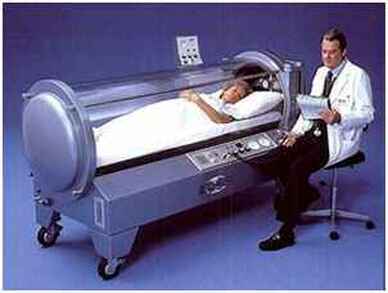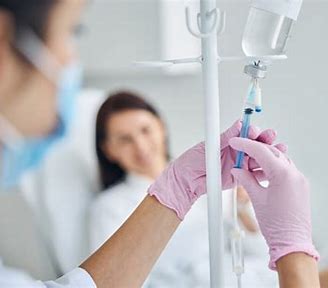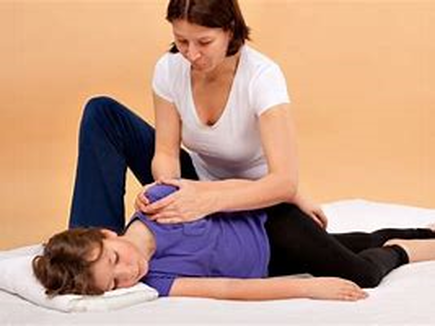What is the most concerning or destructive thing that is going on right now in your child’s world?
Luker, S. (2024) Who May Help?
UNIT 7– 7 CAMs UNIT 7– 8 CAMs
Section 8: CAMs Complementary & Alternative Medicine
PART 5 –
9. hyperbaric oxygen therapy
10. immunoglobulin infusions
UNIT 7– 9 CAMs
Section 9: CAMs Complementary & Alternative Medicine
PART 6 –
11. massage therapy
12. mindfulness & meditation
NOTE: PROCEED WITH CAUTION. Many Complementary and Alternative Medicine (CAMs) treatments are still very controversial and may even be dangerous. Before starting any treatment program, investigate thoroughly, and ALWAYS, ALWAYS talk to your child’s primary physician first.
UNIT 7– 7 CAMs UNIT 7– 8 CAMs
Section 8: CAMs Complementary & Alternative Medicine
PART 5 –
9. Hyperbaric Oxygen Therapy
Hyperbaric Oxygen Therapy (HBOT) is the term for providing oxygen to a patient at concentrations greater than ambient air (21% oxygen under increased pressure). According to the authors Bent, S., Bertoglio, K., et al. (2012) HBOT increases the oxygen content of plasma and body tissues. The clinical study that they considered in the study, was looking for a significant Improvement over a 20-week period, for 16 children with ASD, receiving this treatment. They videotaped the children in play sessions before, during, and after 80 HBOT sessions. Although there were some improvements in blood plasma levels, they “found no improvements in a large number of core autism behaviors.”
Despite the claims that HBOT can cure a number of disorders from diabetes to autism, the U. S. Food & Drug Administration (FDA) has NOT cleared or approved it. What it has been approved for are some cases of decompression sickness suffered by divers; often known as ‘the bends’. In fact, according to the FDA website (www.fda.gov/), they have received 27 HBOT complaints about fraudulent health claims, over the past three years.
< My Thoughts > “…core autism behaviors.”
‘Core autism behaviors’ are universally considered to be problems with social/communication interaction; restricted/repetitive behavior/interests; which impact learning. These ‘behaviors’ vary in their symptoms and severity; thus, appearing as a ‘spectrum’ of behaviors.
As well as creating a practice or program, the principal must meet all qualifying professional standards, certification, and licensing. It is up to you to find out if they do.
10. Immunoglobulin Infusion Therapy
Website https://www.usa.gov/federal-agencies/food-and-drug-administration provides a full manufacture list, with brand information and indicators for which conditions Immunoglobulin Infusion Therapy is used. The condition of Autism Spectrum Disorder (ASD) did NOT appear on the list.
According to DelGiudice-Asch, , G., Suimon, L., et al. et al. (1999) ‘immunoglobulin’ is the part of your blood’s plasma which has antibodies to fight germs or disease. It has been used to treat multiple sclerosis and recurrent epilepsy. Because the ASD disorder shares features of autoimmune disease, it has been hypothesized that it could work for Autism.
Hinds (2014) asks – How harmful would it be to make an appointment to see someone known in ‘autism’ circles as miracle worker? That call to Dr. Goldberg’s office changed Ryan’s life forever. Also, luck and timing were very much a part of our son’s recovery.
Doctor Goldberg told us on that first visit what I already knew to be true. Ryan didn’t really have autism, even though it sure looked like it. I didn’t understand what Neuro-Immune Dysfunction Syndrome (NIDS) meant back then. I didn’t care. I had HOPE! My kid was sick and there was hope that he could get better. Finally, I found someone who not only wanted to help Ryan, but also had a way to do it. And he didn’t think I was crazy – at least not yet.
It was the NIDS approach combined with intensive rehabilitation that helped my son recover from autism. Recovery began by rebuilding his immune system. But just doing the NIDS protocol without any intensive rehabilitation wouldn’t have been enough. Years of behavioral and educational interventions were also necessary to correct Ryan’s deficits in speech and social skills.
NIDS Staff Writer (2019) NIDS Staff Writer (2019) tells us that The Goldberg Approach is treating both the ‘disease’ and ‘dysregulation’ behind the autism. Saying that the safest and best way to fix the ‘dysregulation’ is to have the body correct the imbalance within its own complex mechanisms.
Website https://www.usa.gov/federal-agencies/food-and-drug-administration provides a full manufacture list, with brand information and indicators for which conditions Immunoglobulin Infusion Therapy is used. The condition of Autism Spectrum Disorder (ASD) did NOT appear on the list.
According to DelGiudice-Asch, , G., Suimon, L., et al. et al. (1999) ‘immunoglobulin’ is the part of your blood’s plasma which has antibodies to fight germs or disease. It has been used to treat multiple sclerosis and recurrent epilepsy. Because the ASD disorder shares features of autoimmune disease, it has been hypothesized that it could work for Autism.
Hinds (2014) asks – How harmful would it be to make an appointment to see someone known in ‘autism’ circles as miracle worker? That call to Dr. Goldberg’s office changed Ryan’s life forever. Also, luck and timing were very much a part of our son’s recovery.
Doctor Goldberg told us on that first visit what I already knew to be true. Ryan didn’t really have autism, even though it sure looked like it. I didn’t understand what Neuro-Immune Dysfunction Syndrome (NIDS) meant back then. I didn’t care. I had HOPE! My kid was sick and there was hope that he could get better. Finally, I found someone who not only wanted to help Ryan, but also had a way to do it. And he didn’t think I was crazy – at least not yet.
It was the NIDS approach combined with intensive rehabilitation that helped my son recover from autism. Recovery began by rebuilding his immune system. But just doing the NIDS protocol without any intensive rehabilitation wouldn’t have been enough. Years of behavioral and educational interventions were also necessary to correct Ryan’s deficits in speech and social skills.
NIDS Staff Writer (2019) NIDS Staff Writer (2019) tells us that The Goldberg Approach is treating both the ‘disease’ and ‘dysregulation’ behind the autism. Saying that the safest and best way to fix the ‘dysregulation’ is to have the body correct the imbalance within its own complex mechanisms.
Unit 7– 9 CAMs Section 9. PART 6 – 11. massage therapy 12. mindfulness & meditation
Escalona, et al. (2001) maintains that the children after being in the ‘massage therapy' group studied had less touch-aversion and were becoming more attentive at school; with an increase in ‘on-task’ behavior in the classroom and playground. More frequent massages by a parent or a familiar person, also improved sleep-behaviors, as was reflected in their ‘sleep’ diaries. Parents shared that they expressed ‘really liking’ the before bedtime massage routine as much as their child.
Bestbier, L. & Williams, T. (2017) believe that deep pressure appears to be of immediate benefit to the population with autism and severe intellectual difficulties. Deep pressure has been defined as the ‘sensation produced when an individual is hugged, squeezed, stroked, or held. Sometimes a combination of Deep Touch Pressure (DTP) therapy methods will be successful.
< My Thoughts > “…a combination of Deep Touch Pressure (DTP) therapy methods…”
Many Occupational Therapists use a combination of DPT therapy methods, depending upon the individuals needs. Occupational Therapist’s may often include deep-pressure and/or brushing therapy treatments within sensory-integration treatments.
As well, trained special education classroom teachers will offer a weighted vest or a ‘Wilbarger’ brushing to calm a student who is becoming anxious. All such actions should be approved of as part of the student’s Individualized Educational/ ‘Behavior Intervention Plan’ (BIP).
Mindfulness
Hofer, et al. (2019) have studied a questionnaire created to gather data about the use of Complementary & Alternative Medicine (CAM) by patients in Germany with autism. The specific CAMs the in-study’s data collection, were ‘mind-body’ interventions such as, yoga, music therapy.
< My Thoughts > “…‘mind-body’ interventions.”
While the authors seem to consider yoga, music therapy, first; a newer extension of the mind-body interventions could be ‘mindfulness’ and ‘meditation’.
This questionnaire was used by patients with autism, from a clinic in Germany, in the treatment of somatic and psychiatric disorders, including autism. They found that typically, along with using traditional medicine, parents had chosen to incorporate CAM therapy for treatment of their child’s core autism symptoms.
Also, the study revealed that one of the reasons parents leaned towards CAMs, was due to the seemingly ‘incurable’ nature of autism. Also, they feared that they faced a lack of ‘causal’ treatment options.
< My Thoughts > “…lack of ‘causal’ treatment options.”
By saying parents feared a lack of ‘causal’ treatment options, possibly makes reference to the fact that ‘autism’ is not a ‘disease’, but a ‘neurodevelopmental disorder’. Therefore, one cannot look for a ‘causal treatment’ or, ‘cure’, or a preventative ‘solution’ as one would a ‘disease’.
They also found that the reason parents don’t disclose the use of CAMs to their clinicians, may be due to a fear that they will be ‘judged’, and/or asked to discontinue what could be considered a ‘conflicting’ or ‘risky’ therapy.
After the use of CAMs, patients have reported some satisfaction with symptom improvement, according to outpatient participants recruited for this study. Also, the questionnaire showed evidence that parents seldom disclosed the use of CAMs to their child’s physician.
Hwang, et al. (2015) have investigated recent ‘mindfulness’ intervention studies which successfully addressed problem behaviors, in children with Autism Spectrum Disorder. Along with a pattern of complex impairments such as, heightened anxiety, unwanted stress, and clinically significant problem behaviors which had caused parenting challenges.
‘Mindfulness’ intervention addresses both parents’ issues, as well as that of their child’s. ‘Mindfulness’ is defined as the awareness that emerges through attention to purpose; to being present in the moment, and to experiencing things in moment-by-moment engagement. The ‘mindfulness’ exercised in this article included relaxing, meditating on elements, focusing on breathing, exploring moving, watching and feeling.
< My Thoughts> “…moment by moment engagement…”
Staying in the moment is necessary to becoming engaged enough to learn new things, or even to perform previously learned skills. What is engaging one time, may not be engaging the next time. Changing-up the task to ‘focusing’ on your setting, in a ‘mindful’ way, may be helpful.
Some ‘mindfulness’ suggestions for the family might be to practice ‘waking up with a purpose’, such as to watching the morning’s sunrise. ‘Mindful eating’ by focusing on every morsel or mouthful. Or, by labeling feelings and emotions when taking a nature walk and experiencing the surroundings outdoors. Perhaps naming and comparing the trees, flowers, and birds that you encounter while walking.
Meditation
Siri, K. (2010) 9%/1,001 (Ken Siri recommends trying meditation) …just three months of meditation can create more gray matter in areas of the brain, impacting self-awareness and compassion.
Meditation can quiet your overactive thinking, which can fill your mind with worries and distractions. Meditation helps prevent your mind from wandering so you can stay focused on the task at hand. Meditation also blocks stress and protects your brain from stress-related damage to attention and memory.
Sequeira & Ahmed (2012), in their section about ‘Meditation’, say that along with meditation to treat some symptoms of autism, “Several approaches have been suggested such as acupuncture, message, auditory integration training, detoxification, and neurofeedback.” They caution, “however the studies available so far are insufficient to support or oppose their validity
References:
Bent, S., Bertoglio, K., et al. 2012). Brief Report: Hyperbaric Oxygen Therapy (HBOT) in Children with Autism Spectrum Disorder: A Clinical Trial; Journal of Autism & Developmental Disorders; V42, p1127-1132.
Bestbier, L. & Williams, T. (2017). The Immediate Effects of Deep Pressure on Young People with Autism and Severe Intellectual Difficulties Demonstrating Individual Differences; Occupational Therapy International; V2017, p1-7.
DelGiudice-Asch, G., Suimon, L., et al. (1999). Brief Report: A Pilot Open Clinical Trial of Intravenous Immunoglobulin in Childhood Autism; Journal of Autism & Developmental Disorders; V29:2.
Escalona , A., Field, T., et al. (2001). Brief Report: Improvements in the Behavior of Children with Autism Following Massage Therapy; Journal of Autism Developmental Disorders; V31, p513–517.
Hinds, M. (2014). I Know You’re In There: Winning Our War Against Autism; eBook Edition.
Hwang, Y., Kearney, P., et al. (2015). Cultivating Mind: Mindfulness Interventions for Children with Autism Spectrum Disorder and Problem Behaviors, & Their Mothers; Journal of Child and Family Studies; V24, p3093-3106.
Luker, S. (2024); Know Autism, Know Your Child with < My Thoughts > by Sara Luker; Retrieved online from – www.sarasautismsite.com
NIDS Staff Writer (2019). NIDS Protocol: The Goldberg Approach; Retrieved online from – www.nids.net/
Sequeira, S., Ahmed, M. (2012). Meditation as a Potential Therapy for Autism; Autism Research & Treatment; 2012, p1-11.
Siri, K. (2010). 1,001 Tips for the Parents of Autistic Boys; Skyhorse Publishing, N.Y., N.Y.
Note: DISCLAIMER – Autism ‘intervention’, as with the phrase ‘Early Detection / Early Intervention’, may simply mean to attempt an ‘action’, or attempt to ‘change a course’ or ‘trajectory’ of the person’s autism. Any expectation for a successful ‘change’ must have the cooperation of the participant, the parent, and/or the assigned therapist. Words such as, ‘intervention’, ‘treatment’, ‘therapy’, ‘service’, or ‘program’ imply ‘cure’, or ‘long-term’ positive effect. That is NOT my intention here, and all information is presented without intent or suggestion of status or effectiveness.
End of DAY TWENTY- SEVEN.
Note: Excerpts from the books – (13% indicates location in the Kindle version of the eBook, instead of page numbers).
Sharing of my website and BLOG Comments welcomed. Thank-you to those of you who have sent comments... much appreciated!
Regards,
Sara Luker




 RSS Feed
RSS Feed